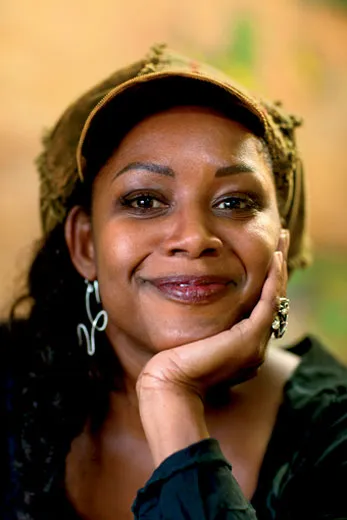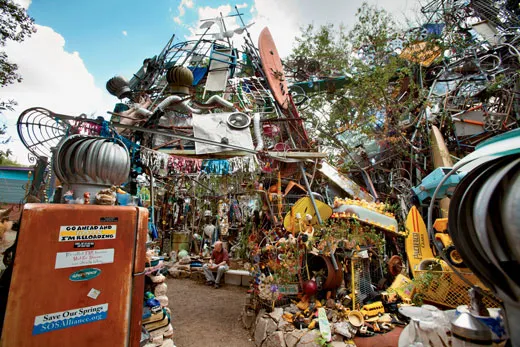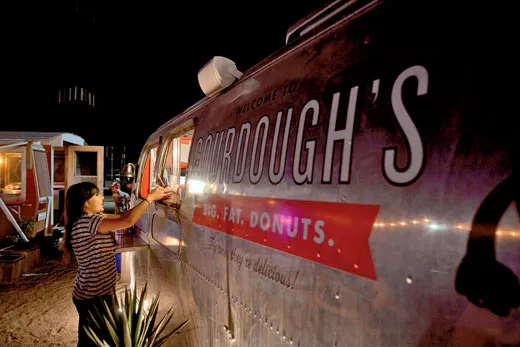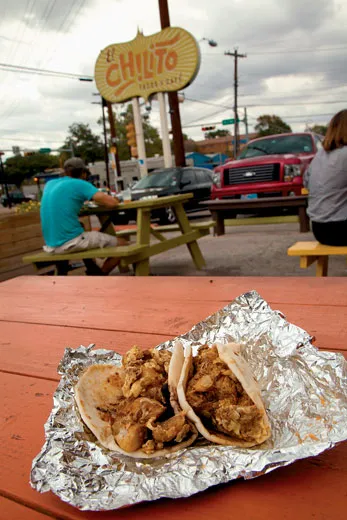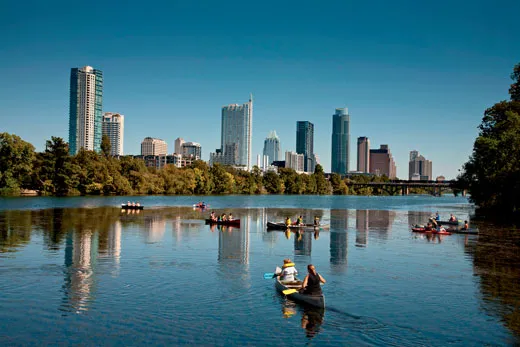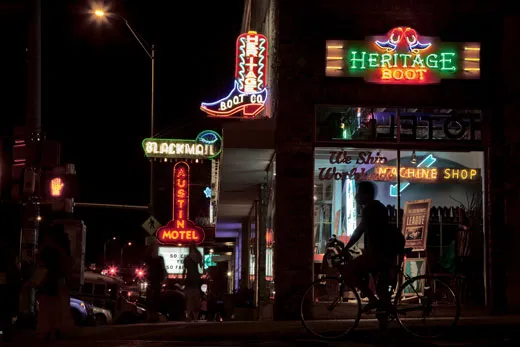Keeping it Weird in Austin, Texas
Aren’t the residents of the proudly hip city of Austin, Texas, just traditionalists at heart?
/https://tf-cmsv2-smithsonianmag-media.s3.amazonaws.com/filer/My-Town-Austin-Texas-Cathedral-of-Junk-631.jpg)
Hipsters of all stripes trek to Austin, Texas. By hipsters, I mean people who love irony but are suspicious of symbolism, who are laid-back without being lazy, who groom their music collections the way Wall Streeters monitor their stock portfolios, people whose relentlessly casual dress is constructed as painstakingly as stanzas in a pantoum.
Hippie or hipster, liberal or libertarian, salaried professional or hourly wageworker, people of all stripes here often refer to their work as their “day jobs,” rather than their careers. You’ll find coffee shop baristas, retail shop clerks, bookstore cashiers as well as doctors, lawyers and computer programmers who view their real work as something else entirely—music, art, an unpublished novel or collecting Popeye mugs.
My first time living in Austin felt more like a layover. I was teaching at the University of Texas and living in the leafy collegiate Hyde Park area, but I was in town only for the semester. I had a full teaching load and was the mother of two toddlers; I was on autopilot. Still, I dug the Austin parenting ethos: Kids cavorted on the outdoor play structures at Phil’s Icehouse or at Amy’s Ice Creams while parents watched from the sidelines, nursing bottles of Lone Star beer, comparing preschools and body piercings.
I was an instant fan of this brand of parenting, as it seemed an extension of Austin’s patio culture. Almost every restaurant, bar and music club has a patio annex as big—if not bigger—than its indoor space, since so much of Austin life is lived outside—pushing kids in a stroller, biking around town, or hiking to the coffee shop or watering hole. All of this is pleasant enough in March, April or May, but in summer, with 100-degree heat, it’s “Survivor” in flip-flops and a straw cowboy hat.
It was during this first grown-up foray in Austin that I became a breakfast taco fanatic, a complete surprise since the only breakfast tacos I’d ever seen were in ads for Taco Bell, where the tortillas were filled with gray florets of ground beef that appeared to be doused in WD-40 and topped with Cheez Whiz. Real breakfast tacos are something else. There’s the migas taco with egg, cheese and fried tortilla chips; the tinga de pollo with chipotle tomato salsa; the enfrijolada with tortillas dipped in black bean sauce and topped with cilantro.
I loved that Austin had strong Chicano roots, was Southern, friendly and even neighborly: the perfect combination of Southern heart, Western spirit and Yankee intellect.
The city’s unofficial motto is “Keep Austin Weird.” It’s a clarion call for residents to support local businesses and everything indie, to say no to big corporations or whomever Austinites suspect of attempting to package their scruffy “slacker-factor” authenticity. Many other cities—Portland, Madison, Santa Cruz and Asheville, North Carolina—have promoted similar campaigns, but it all began in Austin with Red Wassenich, an Austin Community College librarian, who was frustrated that “Austin had been moving away from its funkier roots.”
Wassenich’s 2007 book Keep Austin Weird is a tribute to personal expression, ranging from a mosquito collection to “art cars” (imagine vehicles decorated by Pippi Longstocking or Hulk Hogan). Then there’s Austin’s “yard art,” which can be as simple as showing off a hundred or so of your best pink flamingos, cast-off statuary and upcycled furniture pieces on your front lawn, to more complex projects that give a sculptural middle finger to city ordinances. The rusted three-story hubcap- and bicycle-based Cathedral of Junk was created by Vince Hannemann, a South Austin guy who decided his backyard was as good a place as any to build a cathedral. Now the “weird” rallying cry has expanded to include food trailers where you can buy your heart’s delight—from plate-size doughnuts at Gourdough’s to paper-plated gourmet food at Odd Duck.
Though I could eat my way through Austin 365 days a year, most Austinites would say it’s music, not food, that fuels the city. You can’t throw a cowboy boot without hitting a guitarist, music club or someone hawking playbills for an open-mike night. Austin is the self-styled Live Music Capital of the World, and thanks in part to University of Texas students, up-and-coming alt-country, alt-rock, alt-blues musicians flock to venues like the Broken Spoke, the Mohawk or Antone’s. “The Broken Spoke started out as a honky-tonk, and eventually you had [acts like] Waylon Jennings and Willie Nelson,” says Texas native and UT English professor Michael Adams. “It made being weird normal.” Now, the once-tiny music conference and festival South by Southwest has become one of the country’s largest.
Texans tend to be traditionalists, and though Austinites might seem to head in the opposite direction, they can be just as traditional as anyone from Waco. Austin’s embrace of all things kitsch, camp and retro is little more than a way of preserving the old under a veneer of novelty. Thus the Popeye mugs and the red-rose tattoos with “Mom” in gothic lettering favored by fake sailors everywhere. Name an institution threatened with extinction and you’ll find Austinites of all ages and creeds intent on saving it.
But even Austinites can’t hold onto the past forever. Austin’s ’90s technological boom, spearheaded by Michael Dell, founder of Dell computers, is what brought me to Austin the second time around. I moved to Austin with my then-husband when he got hired at the computer company. We promptly separated, and while my ex contemplated a move to the northern burbs, the kids and I settled in Austin’s largely African-American East Side, where the homes are modest, some so small they’d be garages in posh Hyde Park. You might even swear you were in Antigua or Trinidad: turquoise-blue and tangerine-orange bungalows predominate for a few blocks, centered around a community garden, guarded by towering eight-foot-high sunflowers. Black and Latino kids shimmy down the playground slides and pedal their bikes, knowing they’ve got family on every block, whether related to them or not. I immediately fell in love with edgy and bucolic East Austin, which has its own version of yard art: bottle trees, similar to those on the Gullah islands, and makeshift sculptures that seem half Yoruba-inspired, half homage to Parliament-Funkadelic.
Along with Austin’s new affluence came expansion of the monstrous I-35 and MoPac expressways that displaced many African-Americans. Yet East Austin black folk uphold traditions such as the Juneteeth Day parade, which commemorates the end of slavery in Texas, two and a half years after the Emancipation Proclamation.
What makes Austin a cultural powerhouse are its Latino roots, Tex-Mex vibe and expressions of pachanga—synonymous with “fiesta” but to the tenth power, as exemplified by Pachanga Fest, the premier Austin Latino music festival. Latinos make up more than 35 percent of Austin’s population. Dagoberto Gilb, an Austin essayist and novelist, says that Austin had a ways to go in terms of integration when he arrived from Los Angeles and El Paso 15 years ago: “When I came here, it was like going to Sweden.”
But if there is any city in Texas that strives to bridge divides, it’s Austin. East Austin and South Austin have undergone a renaissance that is half gentrification, half sustainable communities, with a strong locavore movement, community gardens and a new Mexican American Cultural Center.
When my mom comes to town, we eat at Hoover’s, one of the few places you’ll find blacks and whites chowing down in equal numbers, or we’ll head to a Cajun restaurant called Nubian Queen Lola’s. Then there’s El Chilito, where you can get Mexican Coca-Cola, paletas de crema (creamsicles) and tacos. Texas has an abundance of taco joints, but where else but Austin would my mother—probably the only 60-plus African-American vegetarian in all of Kentucky—be able to get a soy chorizo breakfast taco?
My visiting professorship at UT ended a while ago, and I now teach at the Iowa Writers’ Workshop. Yet I still live in Austin, commuting 1,700 miles a week for the privilege. And that seems fitting. Austin links worlds, whether it’s vegans who chain-smoke, twenty-somethings in cutoffs and flip-flops who eat pork belly sliders and do the two-step, or octogenarians who ride Harleys down South Congress.
“I think the BBQ/vegan contradiction is the essence of Austin,” local novelist Sarah Bird tells me when I mention my mom’s soy chorizo habit. “We seem to have cherry-picked and claimed what we like about Texas—dream big/fail big, don’t judge, but do dance. Maybe,” says Bird, hitting upon what may well be the perfect metaphor for the city’s composite, amalgamous nature, “Austin is all about the soy chorizo.”
ZZ Packer, author of Drinking Coffee Elsewhere, is writing a novel about Buffalo Soldiers.
Planning Your Next Trip?
Explore great travel deals
Smithsonian magazine participates in affiliate link advertising programs. If you purchase an item through these links, we receive a commission.
